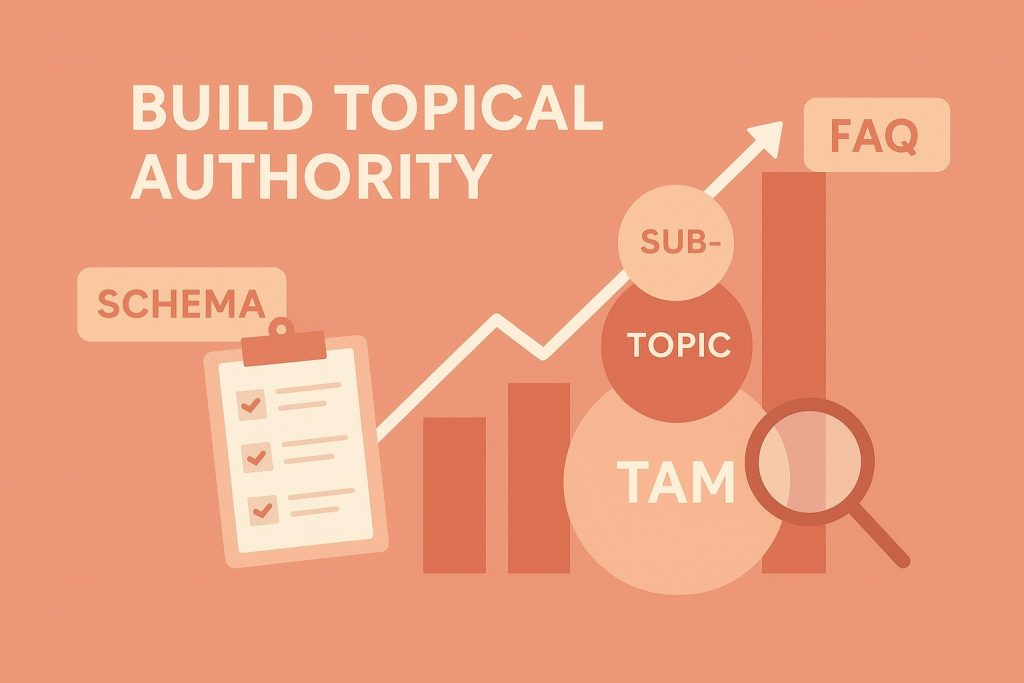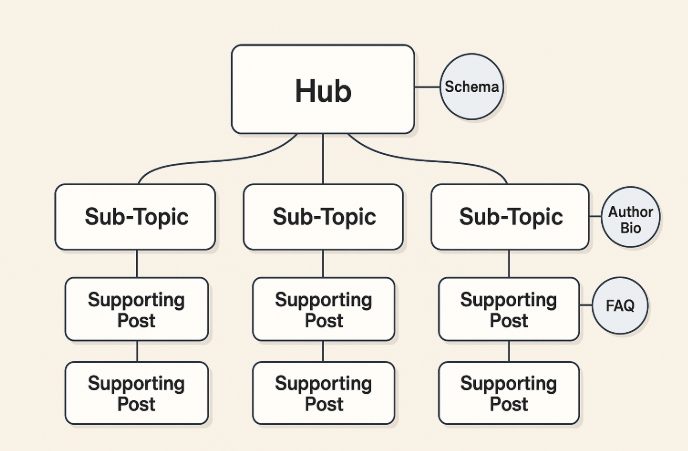Topical authority is the discipline of becoming the most complete, credible source on a clearly defined subject. Practically, it means your site answers the entire “universe of questions” for a niche with depth, structure, and verifiable expertise. Search engines reward this because comprehensive coverage resolves intent better than isolated posts, coherent site architecture improves crawl efficiency, and transparent credibility signals build user trust.
Authority isn’t just rankings—it’s growth. My piece on business growth strategies shows how authority content becomes a growth lever.

When you select a winnable topic, map it semantically, interlink pages safely, annotate entities with schema, and maintain editorial rigor, you create an information ecosystem that keeps readers onsite and compels algorithms to treat your hub as the definitive reference.
Why Topical Authority Beats One-Off Posts
Topical authority consolidates relevance across many queries into a single, reinforced theme. A hub-and-spokes cluster lets crawlers infer relationships quickly while guiding readers from fundamentals to advanced decisions. Instead of chasing keywords one by one, you build a curriculum: a structured path that satisfies beginners, evaluators, and buyers. As the cluster deepens, new content inherits context and authority, accelerating rankings and reducing dependency on external links. In short, your site becomes the “default answer” for the niche.
Authority starts with a crisp boundary statement: the audience, the job they’re trying to do, and the constraints. “We help facility managers choose, install, and maintain water-saving bathroom fixtures in commercial buildings,” or “We help B2B marketers design, deliver, and measure high-ROI email programs.” Boundaries prevent content drift and keep every page aligned to the promise your hub makes to readers.
Why is Topical Authority Important?
Topical authority is vital because it builds your brand’s credibility in both human and search engine eyes. When you consistently cover every angle of a topic with valuable, well-researched content, Google recognizes your expertise and ranks your pages higher for related searches. It’s not just about keywords — it’s about demonstrating deep understanding, trustworthiness, and relevance within your niche.
For readers, topical authority means finding all the answers they need in one place, creating loyalty and repeat visits. For businesses, it strengthens brand positioning, attracts organic traffic, and increases conversion potential. In short, building topical authority transforms your website from “one of many” into the go-to resource for anyone seeking clarity, insight, and solutions within your subject area.
History of Google & the Rise of Topical Authority
- 2011 – Panda launch: Google’s Panda update penalized thin, low-quality pages and rewarded more substantive, original content. This forced sites to invest in depth.
- 2012 – Penguin rollouts: Penguin targeted manipulative link practices, pushing site owners to earn authentic, relevant links instead of spammy networks. Over time it became part of Google’s core algorithm.
- 2013 – Hummingbird update: This overhaul made Google understand natural language, context, and semantics—not just keywords. That shift elevated content that truly answers user intent.
- 2015 – RankBrain integration: Google introduced machine learning to interpret ambiguous queries and match them to the best content “clusters.” Topical authority helps content align with AI’s expectations.
- 2019 – BERT rollout: Google began using deep language understanding to interpret nuance in queries, making well-written, context-rich content more favorable.
- 2022 – Helpful Content Update: Google explicitly favored “people-first” content and demoted pages made mainly for SEO. This validated the purpose of building real authority.
- 2024–2025 – Core & Spam Updates: Recent core updates and spam crackdowns further penalized shallow content, over-optimized pages, and abusive tactics—rewarding clusters with depth, E-E-A-T signals, and strong entity coverage.
Choose and Validate a Topic with SERP and Competitor Gap Analysis
Begin with evidence, not instinct. Read the live SERPs for core and adjacent queries. Note recurring entities, subtopics, content formats, and angles that rank. Identify gaps: questions that competitors ignore, intents left unresolved, or formats missing (tutorials, calculators, templates, comparative explainers). Cluster related queries by intent—awareness, evaluation, implementation—and weigh traffic potential against difficulty and commercial fit. If your business sells fixtures, “water-saving toilets,” “dual-flush performance,” and “basin material durability” form a commercially aligned cluster. If your business sells marketing services, “B2B email strategy,” “list hygiene,” “deliverability setup,” and “automation blueprints” align to revenue.
A Mini Framework for Fast Validation
In a single working session, define ten must-answer questions any credible guide must cover, compare those with the top ten ranking pages, mark the gaps, and draft a provisional hub outline. If you can legitimately cover every question better—backed by expertise, data, or unique examples—you’ve picked a winnable terrain.
Build a Semantic Content Map (Hub, Sub-Topics, Supporting Posts)
Think like a course architect. Your hub provides the 10,000-foot view, sets definitions, previews each sub-topic, and promises an end-to-end journey. Sub-topic pages go deep on critical pillars. Supporting posts resolve narrow, high-intent questions that readers ask once they’re engaged.
Sub-Topics and Supporting Posts in Action
For a bathroom fixtures brand, the hub is “Complete Guide to Water-Saving Bathroom Fixtures.” Sub-topics include “High-Efficiency Toilets,” “Low-Flow Faucets,” “Basins and Materials,” and “Installation & Codes.” Supporting posts answer “Dual-Flush vs Single-Flush Maintenance,” “How to Read WaterSense Labels,” and “Retrofit Cost Breakdown by Region.”
For a B2B email marketer, the hub is “B2B Email Marketing Strategy.” Sub-topics include “List Growth Ethics,” “Segmentation & Lead Scoring,” “Automation Sequences,” and “Deliverability Fundamentals.” Supporting posts cover “Preheader Experiments,” “Plain-Text vs HTML Click Behavior,” and “Warming a New Sending Domain.”
Internal Linking That Feeds Authority (Safely)
Internal links are the circulatory system of a topical map. Link from supporting posts up to sub-topics and the hub to concentrate equity, and link laterally among siblings where readers naturally progress. Use a natural mix of anchor types—exact, partial, semantic, and branded—so links look like human editorial decisions, not patterns engineered for bots. Avoid repeating the same exact-match phrase; vary wording to reflect context and intent.
Natural, Helpful Anchor Examples
- When you define the fundamentals that many clusters rely on, it’s useful to reference a foundational guide to search engine optimization that orients beginners without interrupting your narrative.
- When performance barriers appear in a sub-topic (crawlability, page speed, faceted navigation), point to your technical SEO best practices for readers who need a deeper fix at the right moment.
- When you discuss business outcomes and credibility effects of authority, connect the dots with a practical guide to building brand awareness, so strategy and SEO reinforce each other.
- As readers consider the bigger marketing mix, offer a path into holistic digital marketing strategies that places your topic inside a broader growth system.
let’s Get Proper Examples about to Build Topical Authority
Here’s a list of topical authority content examples about Ice Cream — structured to help you dominate this niche by covering every possible search intent, from fundamentals to trends and product comparisons.
Foundational & Definition Topics
- What is ice cream made of?
- How was ice cream invented?
- What are the main ingredients in ice cream?
- How does ice cream freeze and stay creamy?
- What’s the difference between ice cream and gelato?
Types & Variations
- What are the different types of ice cream (soft serve, custard, gelato, sorbet)?
- What is rolled ice cream and how is it made?
- What is the difference between vegan and dairy ice cream?
- What is nitrogen ice cream?
- What makes artisanal ice cream special?
Recipes & Homemade Guides
- How to make ice cream at home without a machine
- How to make soft serve ice cream at home
- Easy 3-ingredient ice cream recipe
- How to make vegan or lactose-free ice cream
- How to make chocolate or vanilla ice cream from scratch
Flavors & Ingredients
- What is the most popular ice cream flavor in the world?
- How to create your own ice cream flavors
- What are the weirdest ice cream flavors ever made?
- How to make fruit-flavored ice cream
- What makes premium ice cream different in taste and texture?
Storage, Quality & Safety
- How long does ice cream last in the freezer?
- Why does ice cream get icy or form crystals?
- Can you refreeze melted ice cream safely?
- How to store homemade ice cream properly
- How to tell if ice cream has gone bad
Health & Nutrition
- Is ice cream bad for you?
- How many calories are in one scoop of ice cream?
- What are healthy alternatives to traditional ice cream?
- Does ice cream have any nutritional benefits?
- Can you eat ice cream on a diet or cheat day?
Business & Industry Topics
- How to start an ice cream shop
- How much does it cost to open an ice cream parlor?
- Best ice cream franchise opportunities
- How to market an ice cream business
- Seasonal trends in ice cream sales
Product Comparisons & Reviews
- Best ice cream brands in the world
- Best ice cream maker for home use
- Which ice cream brand uses natural ingredients?
- Ice cream vs frozen yogurt: which is healthier?
- Which ice cream brand melts the slowest?
Culture & Trends
- Ice cream trends to watch in 2025
- The rise of plant-based and oat milk ice creams
- How social media transformed ice cream marketing
- Most Instagrammable ice cream shops in the world
- The psychology behind your favorite ice cream flavor
I believe these examples will definitely help you understand the different ways of building topical authority — showing how a single niche like Ice Cream can expand into dozens of subtopics, clusters, and supporting posts that together establish expertise, depth, and trust for your website.
Entities, Schema, and Site Structure
Search engines parse meaning through entities and structure. Name the real-world concepts in copy—standards, brands, measurements, components—and support them with schema. Use Organization schema on the homepage, WebSite and BreadcrumbList for navigation clarity, and Article on substantial pages. When you include Q&A sections, add FAQ schema. For product-adjacent content, apply Product and Review markup when you genuinely qualify. Schema doesn’t replace substance; it amplifies clarity when content already does the work.
How to Operationalize Schema in Your Workflow
Draft content → finalize the heading structure → generate JSON-LD for Article and FAQ (if present) → validate in a structured data testing tool → deploy alongside the page. Keep schema in version control so updates ship with content edits.
E-E-A-T You Can Prove (Not Just Claim)
Expertise and trust are demonstrated by first-hand experience, traceable credentials, and transparent processes. Give every substantial page a byline that links to an author profile with relevant qualifications and work samples. Surface editorial standards: how you research, review, and update pages. Cite reputable sources for statistics and definitions. For bathroom fixtures, publish durability tests and water-use comparisons based on field data and you know what? that’s what, Google E-E-A-T helps to grow content performance with authorities. For email marketing, show live or anonymized deliverability outcomes, SPF/DKIM/DMARC setups, and domain warm-up curves. Add last-review timestamps and brief “what changed” notes so readers see stewardship over time.
State what you did or tested, link who did it, cite where key definitions come from, and clarify when and why the page was updated. Repeat this pattern on every important page so credibility is systematic, not accidental.
Quality Systems for Research, Writing, and Editing
Authority scales when your process is repeatable. Begin with an outline that enumerates search intents, entities to mention, examples to include, and the unique perspective you bring. During drafting, verify claims and add specific examples. Replace generic tips with concrete comparisons, calculations, or workflows. In fixtures content, compare fireclay and ceramic by porosity and chip resistance, not adjectives. In email content, explain deliverability through technical levers—authentication protocols, IP warming, sender reputation—and tie them to business outcomes.
How to Make Every Page Feel “Finished”
Answer the primary question in the first screen, then broaden to “before” and “after” questions the reader will have next. Add a case vignette or mini demo. Close with a clear hand-off: the precise internal page that best continues the journey.
Depth vs Breadth: Cover the Universe, Then Dive Deep
Breadth establishes you as “the place that has everything,” while depth proves you can guide decisions. Your hub should map the full terrain so no core sub-topic is missing. Each sub-topic should then go far beyond listicles—include definitions, standards, methods, tools, and trade-offs. Supporting posts should be definitive answers to narrow questions, written so readers no longer need to return to the SERP.
A Practical Litmus Test
If a motivated reader can complete a complex task using only your cluster—spec, purchase, install, and maintain a fixture; or plan, build, send, and measure a B2B email program—you have depth. If they still need to Google the next step, fill that gap.
Updating and Consolidating Thin or Overlapping Pages
Clusters drift as you publish. Protect equity by auditing for duplicates and thinness each quarter. Pick a single “best page per intent,” fold overlaps into it with 301 redirects, and add a brief on-page note acknowledging what was merged. Expand lean pages with original data, richer examples, and clearer step sequences. When standards change—water-efficiency labels, privacy updates, or deliverability best practices—refresh key sections and update your conclusion to reflect current reality.
Redirects and Reader Trust
Consolidation isn’t just technical; it’s editorial honesty. Tell readers what changed and why, and link to the revised section. This transparency becomes part of your E-E-A-T footprint.
Editorial Cadence and Publishing Rhythm
Authority prefers cadence over bursts. Plan in phases. Phase one ships the hub and four to six core sub-topics. Phase two publishes supporting posts and prunes or rewires internal links. Phase three adds original research, tools, or calculators that others will cite. Work in sprints: brief, draft, edit, fact-check, design visuals, ship, interlink, measure, and iterate. When business priorities evolve, slot changes into the map rather than bolting on orphan content.

A Ninety-Day Launch Plan
Weeks 1–2: finalize boundary, map entities, draft hub.
Weeks 3–6: publish two sub-topics per week; interlink up and sideways.
Weeks 7–10: add supporting posts for each sub-topic; introduce FAQ sections with schema.
Weeks 11–12: audit anchors for variation, fix orphans, consolidate overlaps, and refresh the hub with “What’s new.”
Measurement: Proving Authority Is Growing
Use Search Console to track impressions and average position across your cluster terms and entities. In analytics, segment returning users and multi-page sessions that travel within the cluster. Monitor internal-link flow: links into hubs, links into sub-topics, anchor diversity, and crawl paths. Track topical coverage percentage against your map and flag remaining gaps. When you hit 70–80% coverage, plan an original research asset to attract citations and accelerate authority.
Metrics That Matter to Operations
Coverage completed, pages requiring refresh, orphan count, link variance, CTR changes on entity-rich pages, and conversions attributed to the cluster. Review these monthly and adjust briefs accordingly.
Avoid the Hidden Authority Killers
Over-optimization (stuffed anchors and headings) reads like manipulation. Shallow coverage forces pogo-sticking. Orphan pages sit outside your authority graph and rarely rank. Multiple pages for the same intent split signals. Vague boundaries invite content drift. The remedy is simple but rigorous: map first, write second, link with intention, and consolidate quickly.
An Editorial “Stop Sign” Before Publishing
Ask: does this page target a unique intent, add new information, connect to the next best page, and reflect the latest standards? If any answer is no, fix before ship.
Tools That Help Without Replacing Judgment
Use clustering tools to group queries by intent and similarity so you can see hub, sub-topic, and supporting layers at a glance. Use schema generators for Organization, WebSite, BreadcrumbList, Article, and FAQ, then validate before launch. Use crawlers to reveal orphans, broken links, duplicate H1s, and thin pages while you publish, not after. For measurement, couple Search Console filters by cluster strings with analytics segments for returning visitors. And remember: tools surface patterns; editorial judgment turns patterns into helpful pages.
Where Your Internal Resources Fit
Foundational learning can link to a beginner-friendly SEO explainer when readers need core concepts (a natural hand-off is your page on what is search engine optimization). Technical obstacles should point to deep technical SEO guidance to preserve momentum. Strategy-level readers should be offered brand awareness frameworks and multi-channel marketing strategies to elevate from tactics to growth plans.
Practical Examples You Can Copy
Mini-Case: Bathroom Fixtures
The hub makes the environmental and cost case for water-saving fixtures, introduces standards like WaterSense, and previews a lifecycle cost calculator. Sub-topics explain high-efficiency toilet mechanisms, low-flow faucet aeration, basin materials by porosity and durability, and installation codes with examples. Supporting posts resolve specific questions: dual-flush maintenance, label interpretation, and regional retrofit costs. Internal links keep readers moving forward: from mechanism theory to purchase considerations to maintenance schedules, then back to the hub.
Mini-Case: B2B Email Marketing
The hub frames email’s role in demand generation and sets an editorial calendar. Sub-topics cover ethical list growth, segmentation and lead scoring, automation sequences for onboarding and re-engagement, and deliverability setup. Supporting posts give preheader experiments, plain-text vs HTML click behavior, and domain warm-up pacing. Internal links connect technical setup to landing-page performance (with a pointer to technical SEO where page speed or CWV threaten deliverability gains), then step out to holistic digital marketing strategies for channel alignment.
Key Takeaways
Topical authority is not a trick—it’s a publishing program. Choose a winnable niche, map it semantically, write with evidence and first-hand experience, link with intention, annotate entities with schema, and keep improving winners while consolidating overlaps. If readers can complete their journey inside your cluster without bouncing back to Google, rankings follow and persist.


